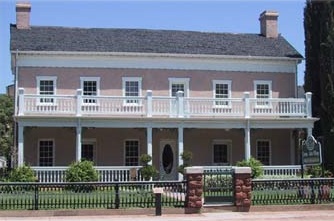
WASHINGTON COUNTY HISTORICAL SOCIETY (Washington County, Utah)
PRATT-BENTLEY HOME
St. George, Utah
LOCATION
76 West TabernacleSt. George, UT 84770-3420
37° 6' 31" North Latitude, 113° 35' 1" West Longitude
Plat A, Block 25, Lots 2, 3, and 4 on the old pioneer map of St. George.
Now part of the Green Gate Village.
DESCRIPTION
The Orson Pratt House, built in 1862, is a two-story, gable-roofed house, rectangular in shape with the broad side to the street. The six-bay facade is symmetrical except for the slight misalignment of the central doorway. Its classical appointments and symmetrical design are typical of the vernacular architecture used by the Mormon pioneers during their early years of settlement, roughly Ib49-lb/0s. The house is constructed of adobe brick, the most popular building material of that period, and was probably first stuccoed in the late lauus in order to protect the sort adobe room the elements and to provide a cleaner, more refined appearance. Chimneys at both gable ends reinforce the symmetrical appearance of the house.The house was altered by the c. 1930 enclosure of the second-story porch and the creation of arches across the tops of the porch openings. Two of the three doorways on the facade are either additions made about this same time or were built as part of the original house, which was claimed to have been a house/store combination, allowing separate access to living and business areas. The two-story rear addition was probably built on before that time.
Recent rehabilitation and restoration efforts on the house have returned it to much of its pre-alteration appearance. The two-story front porch is a reconstruction of the nineteenth-century porch that was on the house in an early photograph and which, if not original, was a very early addition. A portion of the balustrade was found during the removal of the front porch addition and was used as a pattern for an exact reconstruction of the balusters, top and bottom rails, and newel posts. The brackets are exact replicas of those originally on the porch as shown in the early photograph of the house. The exterior walls were re-tinished with a stucco/fiberglass matrix which provides added strength to the structure. Rehabilitation of both the interior and exterior was made in an effort to conform to the Secretary of Interior's Standards for Rehabilitation, and the project is currently under review by the National Park Service for certification. The building will be used as office space upon completion.
HISTORY
Orson Pratt, usually referred to as the true intellectual of the early apostles of the L.D.S. Church, was sent to St. George to share the responsibilities of the Cotton Mission. Orson Pratt Jr. was named postmaster even before the vanguard of the pioneers left Salt Lake City.In 1962, the Pratt family built the large (for the times) house directly north of the public square where later the St. George Tabernacle and Woodward School would find a home. It was the first permanent home built in St. George. The building had two stories and was constructed with a black lava rock foundation. The walls were 18 inches thick and made of locally produced adobes with the sand and gravel laboriously mixed by hand, poured into molds, and then dried in the hot Dixie sun. As with most buildings of the time they were used in double thicknesses throughout the structure. The Pratt family lived on the second story. The ground floor was fitted out to be both a small dry goods store and St. George's first post office.
Local rumor, never completely verified, insists that Pratt and Apostle Erastus Snow did not agree on many issues and Pratt asked permission to leave the Cotton Mission. Whether this was true or not, he was called to a mission to Austria in 1864.
Before he left, he traded homes with Richard Bentley in Salt Lake City. The Bentley family continued to operate the small store out of the room on the west end of the first floor. But they also converted the main portion of the downstairs into living quarters. Bentley's wife, Elizabeth, was in the forefront of the ladies called to develop the silk industry in Utah's Dixie and one large room upstairs was devoted to this ill-starred adventure. Elizabeth hatched silk worm eggs and fed the worms local mulberry leaves gathered by her grandchildren.
After Richard Bentley's death the building passed into the hands of his son, prominent local businessman, William Oscar Bentley, whose family lived there until the early 1920s when he built a more modern home just around the corner.
When the family moved out, the house was divided into apartments and suffered several unsightly "modern" changes and additions. By 1981, the building was is a state of complete decay and marked for demolition by the city.
In 1981, the place was purchased by Dr. Mark and Barbara Greene. This home was made a centerpiece of the Green Gate Village bed-and-breakfast complex. A Preservation Easement was granted to the Utah Heritage Foundation (now Preservation Utah). The walls and the woodwork are the original and the prize-winning restoration has remained true to the period and the memories of the older people.
Put on the National Register of Historic Places (#1983003199) on August 11, 1983.
The Orson Pratt House is significant as the only remaining house in Utah associated with Orson Pratt, one of the most influential and important leaders in the first half-century of The Church of Jesus Christ of Latter-day Saints, and a noted mathematician, astronomer, scientist, author, public servant and educator. Pratt, as a member of the first Quorum of the Twelve, the governing body of the church under the First Presidency, was involved not only in directing ecclesiastical and settlement activities, but also, as a philosopher and intellectual, made unique contributions to Mormpnism by articulating and systemitizing religious philosophies of the church. Self-educated in a wide range of disciplines, he gained international recognition for some of his published mathematical and astronomical theories, and was a leading proponent of education in territorial Utah. He served for thirteen terms in the territorial legislature, eight as Speaker of the House of Representatives. Orson Pratt had this house built in 1862 while helping direct the settlement of St. George and the Cotton Mission, the LDS Church's attempt to establish a cotton industry in the warm southwestern corner of the state. Although he lived here for only about two years, residing in Salt Lake City for most of his years in Utah, none of his other houses remain standing. His home in Nauvoo, Illinois, headquarters of the LDS Church from 1839 to 1846, is still standing.
In 1861, Brigham Young, fearing cotton shortages as a result of the Civil War, sent a group of colonizers to the Virgin River area in what is now southwestern Utah to establish a cotton industry in that warm climate. Under the leadership of apostles Orson Pratt, Erastus Snow and George A. Smith, the group established the commu nity of St. George late in 1861. Pratt, though presiding leader of the group, was not gifted as a colonizer, and much of the responsibility for settlement was assumed by Snow and Smith. Orson Pratt first settled upriver from the main settlement, but joined them a few months later in the spring of 1862 when he accepted the office of postmaster there. He built this two-story adobe house soon after, but lived here for only a short time, being called to the territorial capital by his duties as a legislator and later to Great Britain as a missionary. In 1864 he sold the house to Richard Bentley, whose family retained ownership of it for more than a century. This settlement effort in St. George was Orson Pratt 1 s only colonizing attempt. He spent the remainder of his life either in Europe as a missionary or in Salt Lake City. Richard Bentley, a prominent political, civic, and business leader in St. George, operated the first mercantile business in the city out of part of the first floor area of the house from 1864 until 1875 He served in many civic positions including Water Commissioner (1871), City Alderman (1872), County Treasurer, and Mayor for three terms.
Orson Pratt was born September 19, 1811 in Hartford, Mew York to Jared and Charity Dickinson Pratt. The fourth of six children, he had little opportunity for education as a youth, but pursued studies on his own and gained proficiency in several subjects, including mathematics, astronomy and physical sciences.
A major turning point in his life occurred on his nineteenth birthday when he was baptized a member of The Church of Jesus Christ of Latter-day Saints by his older brother, Parley P. Pratt. For the remaining fifty years of his life, he served the church tirelessly in many positions, continuing faithfully with the organization as it moved from New York, to Ohio, to Missouri, to Illinois, then to Utah. Soon after his conversion he began proselyting as a missionary, and in 1835 he was chosen as a member of the first Quorum of the Twelve of the church, which had been organized in 1830. (His brother Parley was also chosen as a member of that body.) The Quorum operated under the direction of the prophet and president of the church, and its members were called to help direct the preaching and administrative affairs of the church. Their responsibilities usually included serving proselyting missions that often lasted for two or three years. Orson Pratt was sent to Scotland on such a mission soon after his appointment to the Quorum, and, in all, he crossed the Atlantic Ocean sixteen times in response to the call to serve. His success as a missionary in the British Isles was phenomenal, bringing thousands into the church through the power of both his speech and his writing, having authored and published many pamphlets and written for and edited the Mi "Menial Star, the IDS Church publication in Great Britain.
While serving in his church positions he found time to pursue his educational interests as well. He discovered a law governing planet rotation in 1850, published Pratt's Cubic and Bi-Quadratic Equationsin 1866 in England, and later published an astronomical work, Key to the Universe. Although such discoveries and publications gained him some international attention at the time they were brought forth, he never attained international prominence as a mathematician and astronomer, primarily because, due to lack of time and proper facilities, he did not empirically prove his theories. Pratt's abilities, however, were remarkable enough to prompt Richard Anthony Proctor of the Royal Astronomical Society to pronounce him to be "one of only four real mathematicians in the world."
His keen perception and gift of expression enabled him to expand and combine the doctrines and principles introduced somewhat randomly by Joseph Smith, founder and first prophet of the LDS Church, into a philosophic system of the Mormon religion. He would often combine his own scientific knowledge with Biblical and Mormon scripture to create a philosophy which reinforced both. He was chosen by Brigham Young in 1870 to represent the church in the celebrated three-day debate on polygamy with Dr. John P. Newman, an eloquent Methodist.minister. Although the debate was officially ruled a draw, most newspapers around the country conceded Pratt the victor.
Orson Pratt is also credited for devising the symbols of the Deseret Alphabet, a phonetic alphabet which church leaders viewed as a major breakthrough in aiding thousands of Mormon converts from foreign countries to easily learn English. He transcribed and published the Book of Mormon in the Deseret Alphabet in 1869, but the new alphabet never gained widespread acceptance. In 1877 he arranged the Doctrine and Covenants and the Book of Mormon, canonized Mormon scriptures, into paragraphs with footnotes and references, a format which remained virtually unchanged for over one hundred years. He also served as Church Historian from 1874 until his death in 1881.
Although his main interests were in preaching the gospel and engaging in educational pursuits, Orson Pratt was also involved in the initial settlement of the church in Utah. As a member of the vanguard company of Mormon pioneers who led the trek across the plains to Utah in 1847, he and Erastus Snow were sent ahead as scouts when the party neared the Salt Lake Valley. Alternating walking on foot and riding the single horse that they shared, Pratt and Snow were the first two men of the Mormon group to enter and explore the valley. On August 2, 1847, Orson ran the official survey of Salt Lake City, ascertaining the altitude of the valley and determining its longitude and latitude at the same time.
Education and learning were extremely important to Orson Pratt, perhaps second only to preaching the gospel, and "he dreamed of establishing a great educational system among the Saints, where the more cultured things of life could be taught." He never realized that dream, however, due to the lack of interest by the people, who had little time for anything but providing a living for themselves in the desert wilderness, and due to the unsupportive and even opposing attitude of practical-minded Brigham Young. Pratt served for a time as an instructor and regent at the University of Deseret, and was well known in the Salt Lake area for his series of twelve lectures on astronomy, which stirred great interest in the subject. In 1869 an observatory was constructed for him at the southeast corner of Temple Square from where he made astronomical observations, the most noted of which were his detailed observations of the lunar cycle in 1878, which were depicted in fifty granite moonstones inserted in the temple walls as part of its symbolic decoration. (The observatory was razed in 1909.)
His political activities included serving in the territorial legislature for thirteen terms, eight as Speaker of the House of Representatives. While in that position, he was instrumental in securing passage of the act giving women in Utah the right to vote in 1870; Utah was the second state or territory in the Union to grant that right. He also served for a time on the Salt Lake City Council.
Orson Pratt died in 1881 at his home in Salt Lake City, survived by his several wives and forty-five children. His eulogy included all the expected praise and respect for one of his abilities and position, but, unlike any of his fellow luminaries in the church, he stood alone as a philosopher and intellectual.
BIOGRAPHY
Orson Pratt was one of the most remarkable men in LDS Church history. He joined the church in Kirkland, Ohio in 1830 at the age of 19 and was immediately called by Joseph Smith to serve the first of several missions. He was the first Elder's Quorum president in the Church and subsequently an original member of the Quorum of the Twelve Apostles wherein he served for the balance of his lifetime. Orson experienced first hand the hardships, persecution and many forced relocations of the saints. After an arduous trek across the great plains and Rocky Mountains in the summer of 1847, Orson and Erastus Snow were the first two men to view and enter the Great Salt Lake Valley in advance of Brigham Young's wagon party. Because of Orson's mathematical expertise he helped lay out the plat maps for that and other Utah cities to follow. In addition, he was an author, editor, publisher, scientist and an educator. He crossed the continent many times on horseback, wagon, and rail, and crossed the Atlantic Ocean sixteen times on three-masted sailing ships, taking the gospel message to the British Isles.In 1861 Orson Pratt and Erastus Snow were called by Brigham Young to lead a group of 309 families to relocate to Southern Utah and establish the city of St. George. Their mission was to grow cotton, raise sheep and even silk worms in order to supply the dozens of new Utah cities to the north with much needed raw materials for fabrics. In 1864, Pratt was called by Brigham Young on yet another proselytizing mission. This time to Austria, where they were denied permission to preach by the government, and thence again to England where he managed the perpetual immigration fund.
Richard & Elizabeth Bentley came to St. George in 1864 after trading their house in Salt Lake for Orson Pratt's home in St. George. They had six children:
Emma Demeba (married Edwin Delworth Woolley Jr.)
Mary Lavinia (married Edwin Gordon Woolley)
William Oscar (married Mary Ann Mansfield)
Annie Elizabeth (married Nelson Terry)
Franklin Richards (married Marion Carter)
Joseph Charles (married Margaret Ivins, Gladys Woodmanfee, and Maude Taylor)
After the death of Elizabeth, Richard married Hannah Cox Welch. He died in 1906.
For a more detailed biograpy, click here.
PHOTOS
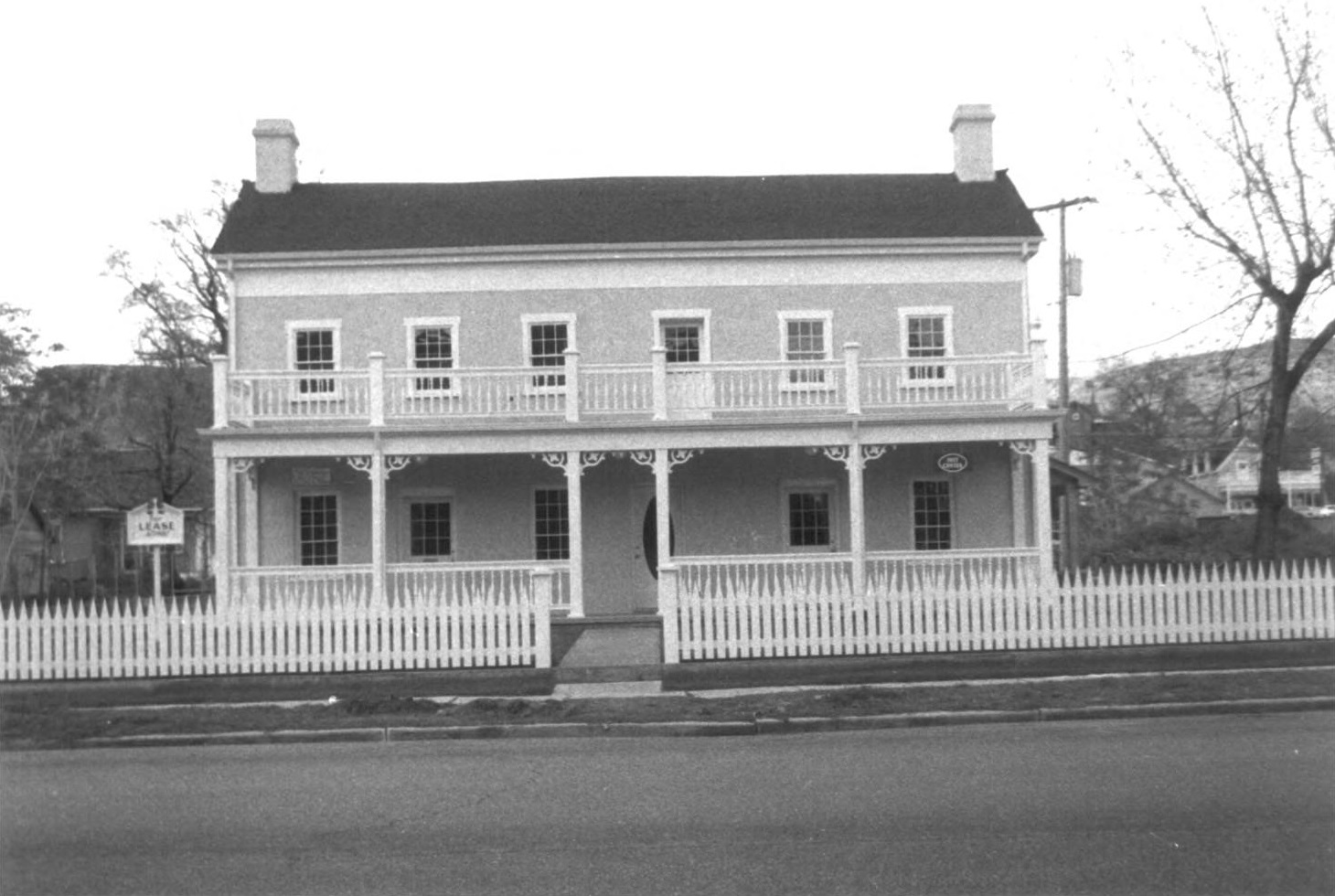 Front/south side of the home (Philip F. Notarianni, April 1983) |
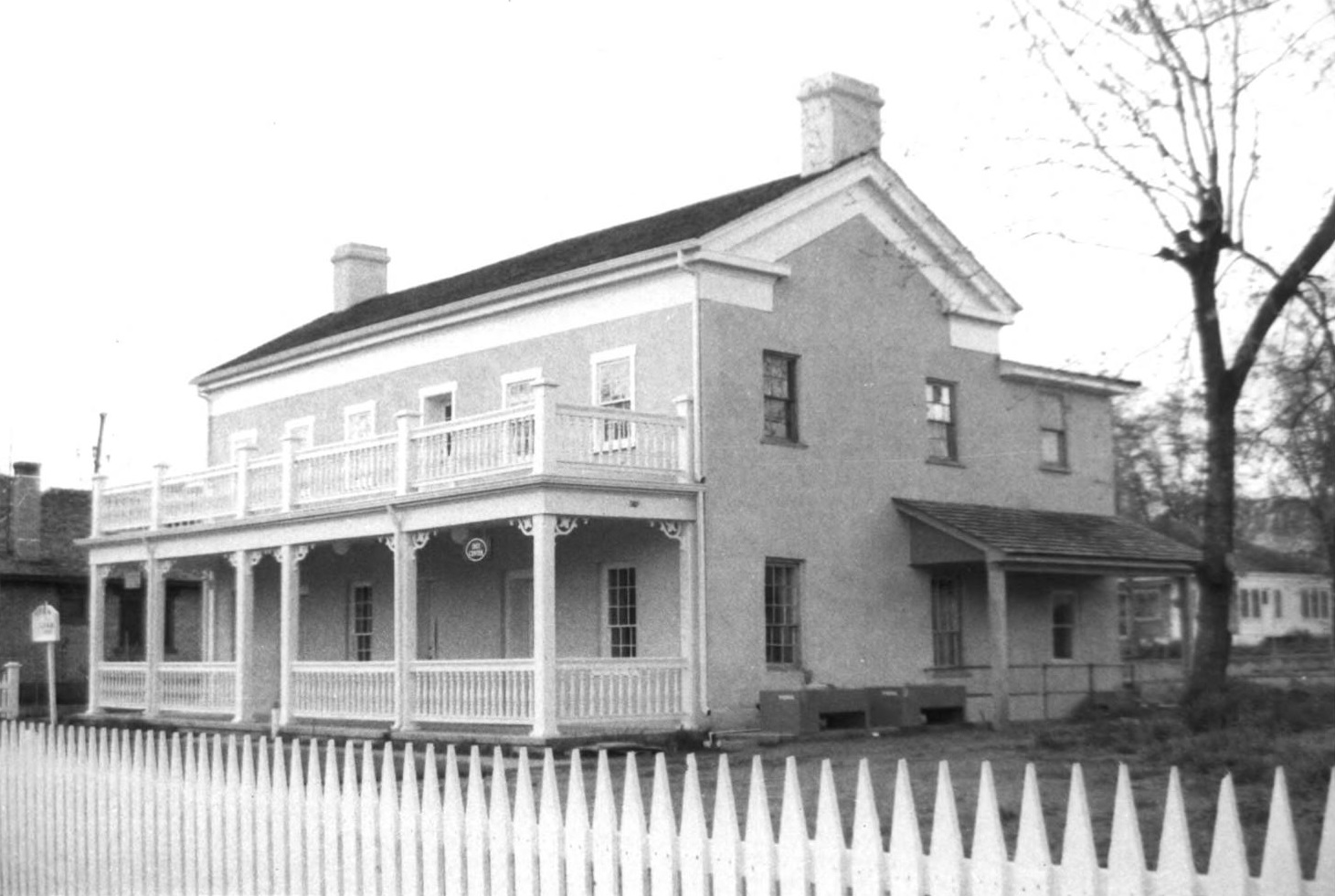 Southeast corner of the home (Philip F. Notarianni, April 1983) |
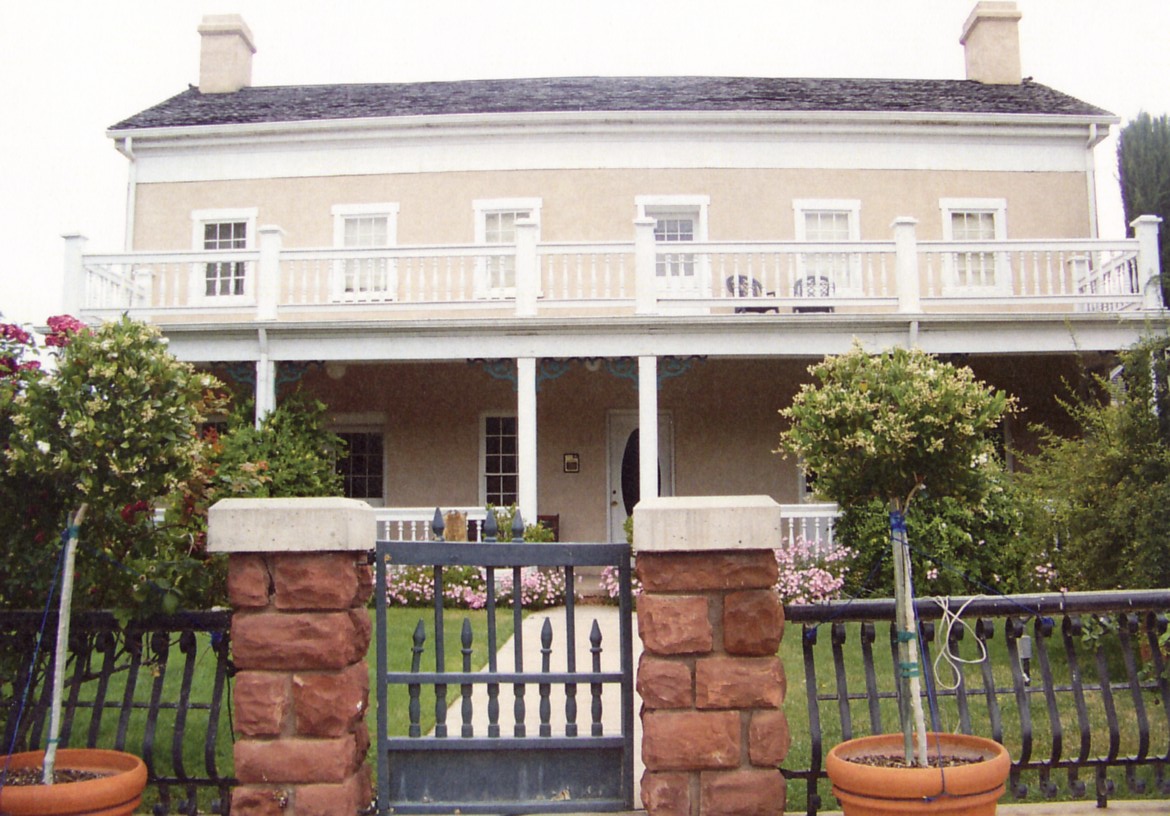 WCHS-00573 Front view |
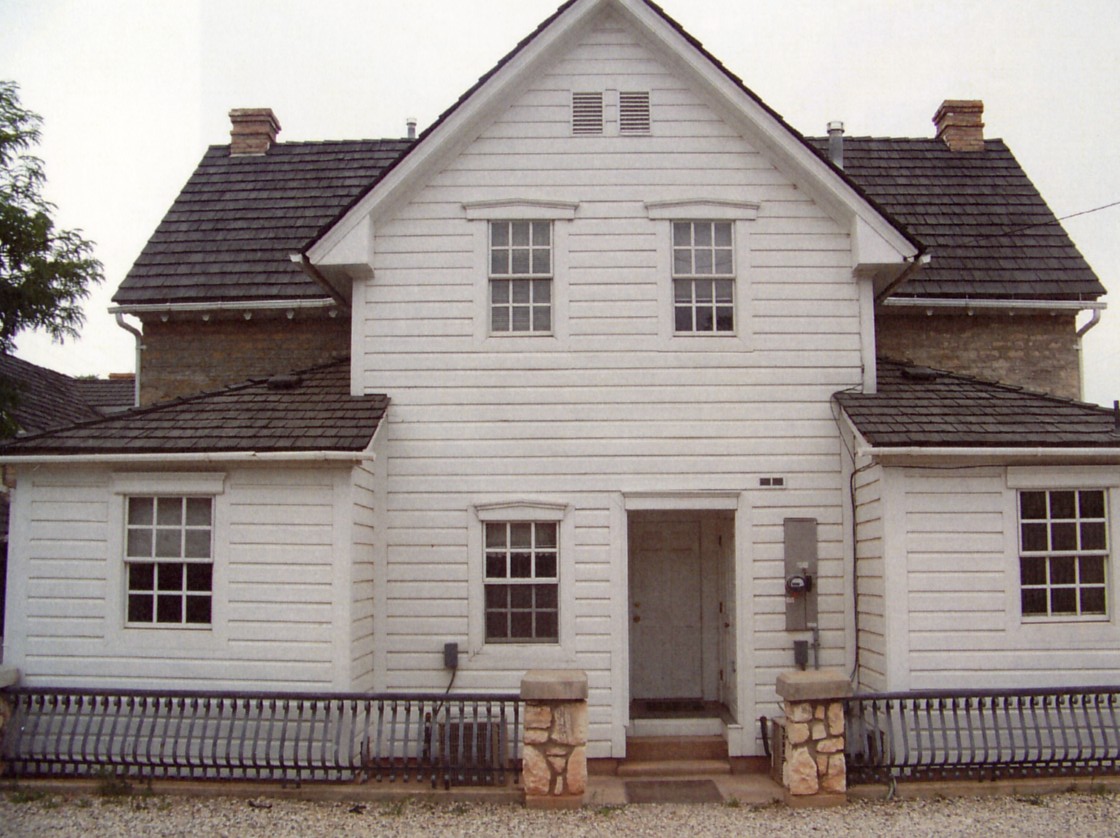 WCHS-00574 Back view |
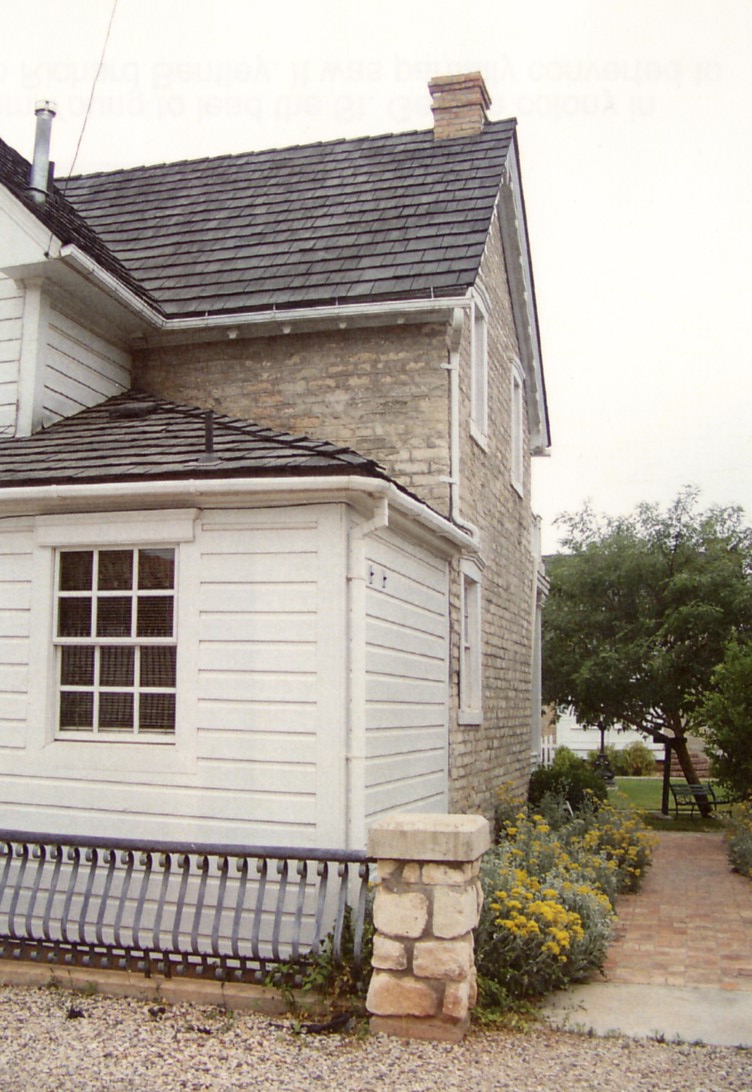 WCHS-00575 Side view |
Other WCHS photos:
WCHS-00547 Jon Bowcutt sketch of the Orson Pratt/Bentley Home
WCHS-03810 A Woodward Junior High School band member in front of the Orson Pratt Home in 1955
Other photos on the web:
Photos from the National Register of Historic Places nomination form
Other photos in documents:
Images of Faith book by Lynne Clark, See pp. 86, 113, 195, and 288.
REFERENCES
Historical Buildings of Washington County (Volume 1), pp. 16-17.Landmark and Historic Sites: City of St. George
First edition, July 2, 2009, Pages 4-1 through 44-2
Compiled by the St. George Community Development Department
Landmark & Historic Sites: Informational Guide of Historical Sites within the City of St. George
Second edition, Revised 2011, Pages 65 and 66
Compiled by the St. George Community Development Department
Landmark & Historic Sites: Informational Guide of Historical Sites within the City of St. George
Third edition, Revised 2015, Pages 71 and 72
Compiled by the St. George Community Development Department
National Register of Historic Places, Inventory - Nomination Form
Green Gate Village Brochure and Self-Guided Tour
Green Gate Village Information Page on the Orson Pratt House
Book: "Autobiography of William Oscar Bentley, Jr."
by William Oscar Bentley (1884-)
Privately published 1961, 82 pp.
Book: "Treasured histories of the William Oscar Bentley family"
by LeRoi Bentley
Salt Lake City, UT: Publisher's Press, 1984. 416 pp.
About William Oscar Bentley (1884-) and his family.